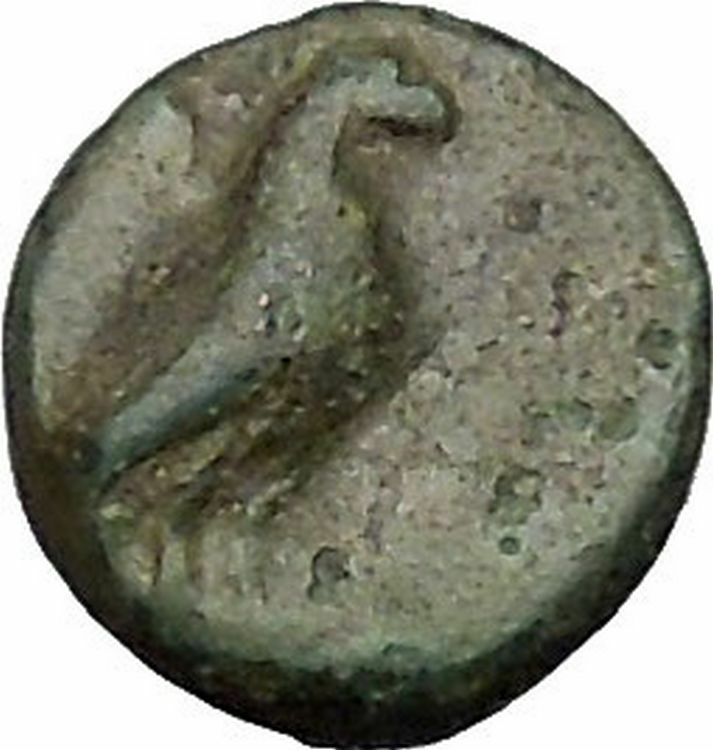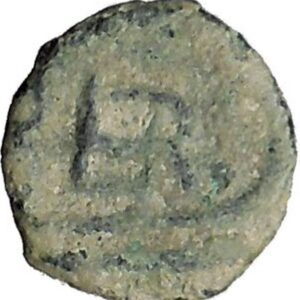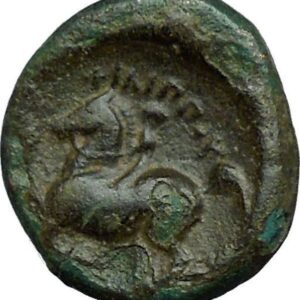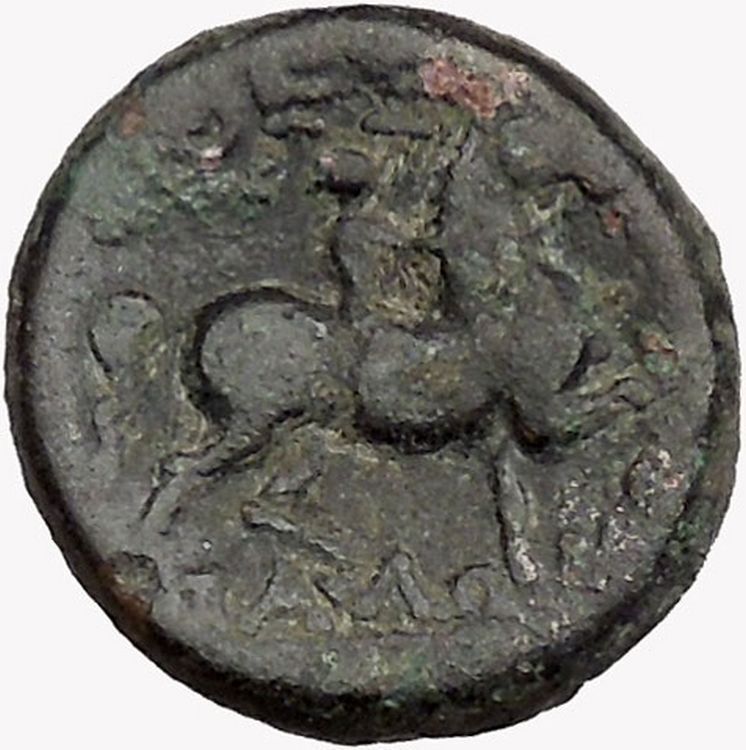|
Greek city of Pharsalos
in Thessaly
Bronze Trichalkon 20mm (6.06 grams)
Struck
circa 3rd century B.C.
Reference: BCD Thessaly 674.5
Helmeted head of
<=”” font=”” color=”#000000″>
Athena
facing slightly
left with shield and spear.
ΦΑΡΣΑΛIΩΝ, Horseman galloping right, brandishing flail, attendant behind .
One of the more important towns of Thessaly, Pharsalos was
built on the northern slopes of Mt. Narthakios. It was the scene of Caesar’s
famous victory over Pompey in 48 B.C.
You are bidding on the exact item pictured,
provided with a Certificate of Authenticity and Lifetime Guarantee of
Authenticity.
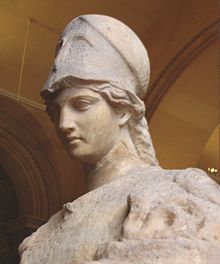
Helmeted Athena with the cista and Erichthonius in his serpent form.
Roman, first century (Louvre
Museum)
In
Greek religion
and
mythology
, Athena or Athene, also
referred to as Pallas Athena/Athene , is the goddess of wisdom, courage,
inspiration, civilization, law and justice, just warfare, mathematics, strength,
strategy, the arts, crafts, and skill.
Minerva
is the
Roman goddess
identified with
Athena.
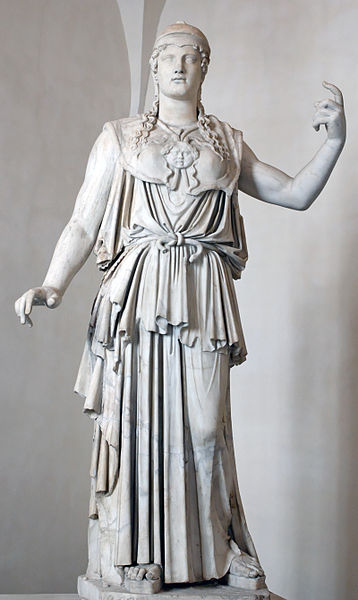
Athena is also a shrewd companion of
heroes and is the
goddess
of heroic endeavour. She is the
virgin
patroness of
Athens
. The Athenians founded the
Parthenon
on the Acropolis of her namesake
city, Athens (Athena Parthenos), in her honour.
Athena’s veneration as the patron of Athens seems to have existed from the
earliest times, and was so persistent that archaic myths about her were recast
to adapt to cultural changes. In her role as a protector of the city (polis),
many people throughout the Greek world worshiped Athena as Athena Polias
(Ἀθηνᾶ Πολιάς “Athena of the city”). The city of
Athens
and the goddess Athena essentially bear
the same name, “Athenai” meaning “[many] Athenas”.
Patroness

Athenian
tetradrachm
representing the
goddess Athena
Athena as the goddess of philosophy became an aspect of the cult in Classical
Greece during the late 5th century B.C. She is the patroness of various crafts,
especially of weaving
, as Athena Ergane, and was
honored as such at festivals such as
Chalceia
. The metalwork of weapons also fell
under her patronage. She led battles (Athena
Promachos or the warrior maiden Athena Parthenos) as the
disciplined, strategic side of war, in contrast to her brother
Ares, the patron of violence, bloodlust and slaughter—”the raw force
of war”. Athena’s wisdom includes the cunning intelligence (metis) of
such figures as Odysseus
. Not only was this version of Athena
the opposite of Ares in combat, it was also the polar opposite of the serene
earth goddess version of the deity, Athena Polias.
Athena appears in Greek mythology as the patron and helper of many heroes,
including Odysseus
,
Jason
, and
Heracles
. In
Classical Greek
myths, she never consorts with
a lover, nor does she ever marry,earning the title Athena Parthenos. A
remnant of archaic myth depicts her as the adoptive mother of
Erechtheus
/Erichthonius
through the foiled rape by
Hephaestus
. Other variants relate that
Erichthonius, the serpent that accompanied Athena, was born to
Gaia
: when the rape failed, the semen landed on
Gaia and impregnated her. After Erechthonius was born, Gaia gave him to Athena.
Though Athena is a goddess of war strategy, she disliked fighting without
purpose and preferred to use wisdom to settle predicaments.The goddess only
encouraged fighting for a reasonable cause or to resolve conflict. As patron of
Athens she fought in the Trojan war on the side of the Achaeans.
Mythology
Lady of Athens
Athena competed with
Poseidon
to be the patron deity of Athens,
which was yet unnamed, in a version of one
founding myth
. They agreed that each would give
the Athenians one gift and that the Athenians would choose the gift they
preferred. Poseidon struck the ground with his
trident
and a salt water spring sprang up; this
gave them a means of trade and water—Athens at its height was a significant sea
power, defeating the
Persian
fleet at the
Battle of Salamis
—but the water was salty and
not very good for drinking.
Athena, however, offered them the first domesticated
olive tree
. The Athenians (or their king,
Cecrops
) accepted the olive tree and with it
the patronage of Athena, for the olive tree brought wood, oil, and food.
Robert Graves
was of the opinion that
“Poseidon’s attempts to take possession of certain cities are political myths”
which reflect the conflict between matriarchal and patriarchal religions.
Other sites of cult
Athena also was the patron goddess of several other Greek cities, notably
Sparta, where the archaic cult of
Athena Alea
had its sanctuaries in the
surrounding villages of
Mantineia
and, notably,
Tegea
. In Sparta itself, the temple of Athena
Khalkíoikos (Athena “of the Brazen House”, often
latinized
as Chalcioecus) was the
grandest and located on the Spartan acropolis; presumably it had a roof of
bronze. The forecourt of the Brazen House was the place where the most solemn
religious functions in Sparta took place.
Tegea was an important religious center of ancient Greece, containing the
Temple of Athena Alea
. The temenos was founded by
Aleus
,
Pausanias
was informed. Votive bronzes at the
site from the Geometric and Archaic periods take the forms of horses and deer;
there are
sealstone
and
fibulae
. In the Archaic period the nine
villages that underlie Tegea banded together in a
synoecism
to form one city. Tegea was listed in
Homer
‘s
Catalogue of Ships
as one of the cities that
contributed ships and men for the
Achaean assault on Troy
.
Judgment of Paris

Aphrodite is being surveyed by Paris, while Athena (the leftmost
figure) and Hera stand nearby.
El Juicio de Paris
by
Enrique Simonet
, ca. 1904
All the gods and goddesses as well as various mortals were invited to the
marriage of Peleus
and
Thetis
(the eventual parents of
Achilles
). Only
Eris
, goddess of discord, was not invited. She
was annoyed at this, so she arrived with a golden apple inscribed with the word
καλλίστῃ (kallistēi, “for the fairest”), which she threw among the goddesses.
Aphrodite, Hera, and Athena all claimed to be the fairest, and thus the rightful
owner of the apple.
The goddesses chose to place the matter before Zeus, who, not wanting to
favor one of the goddesses, put the choice into the hands of Paris, a
Trojan prince. After bathing in the spring of
Mount Ida
(where Troy was situated), the
goddesses appeared before Paris. The goddesses undressed and presented
themselves to Paris naked, either at his request or for the sake of winning.

Paris is awarding the apple to Aphrodite, while Athena makes a face.
Urteil des Paris by
Anton Raphael Mengs
, ca. 1757
Still, Paris could not decide, as all three were ideally beautiful, so they
resorted to bribes. Hera tried to bribe Paris with control over all
Asia and Europe
, while Athena offered wisdom, fame and
glory in battle, but Aphrodite came forth and whispered to Paris that if he were
to choose her as the fairest he would have the most beautiful mortal woman in
the world as a wife, and he accordingly chose her. This woman was
Helen
, who was, unfortunately for Paris,
already married to King
Menelaus
of
Sparta
. The other two goddesses were enraged by
this and through Helen’s abduction by Paris they brought about the
Trojan War
.

The Parthenon
, Temple of Athena
Parthenos
Masculinity and
feminism
Athena had an “androgynous compromise” that allowed her traits and what she
stood for to be attributed to male and female rulers alike over the course of
history (such as Marie de’ Medici, Anne of Austria, Christina of Sweden, and
Catherine the Great)
J.J. Bachofen advocated that Athena was originally a maternal figure stable
in her security and poise but was caught up and perverted by a patriarchal
society; this was especially the case in Athens. The goddess adapted but could
very easily be seen as a god. He viewed it as “motherless paternity in the place
of fatherless maternity” where once altered, Athena’s character was to be
crystallized as that of a patriarch.
Whereas Bachofen saw the switch to paternity on Athena’s behalf as an
increase of power, Freud on the contrary perceived Athena as an “original mother
goddess divested of her power”. In this interpretation, Athena was demoted to be
only Zeus’s daughter, never allowed the expression of motherhood. Still more
different from Bachofen’s perspective is the lack of role permanency in Freud’s
view: Freud held that time and differing cultures would mold Athena to stand for
what was necessary to them.
Farsala (Greek:
Φάρσαλα), known in Antiquity as
Φάρσαλος
, Pharsalos or Pharsalus,
is a city in southern
Thessaly
, in
Greece
. Farsala is located in the southern part
of
Larissa Prefecture
, and is one of its largest
cities. The city is linked with
GR-3
, the old highway linking
Larissa
and
Lamia
and is also accessed by
GR-30
linking
Karditsa
and
Volos
. The
GR-1
/E65
and
E75
superhighway runs to the east of the city.
Several mountain ranges lie to the South, while the
Thessalian Plain
lies to the North, some hills
to the East and the Farsalian Fields in the central part. Farsala is located SE
of Karditsa
, S of
Larissa
, W of
Volos
and N of
Lamia
.
The area is an economic and agricultural centre of the province. The
population are mainly rural especially with
cotton
production and breeding, one of the many
are in local production units in agricultural production as well as clothing and
textile industries. Farsala is famous for its distinctive
halva
. The population (2006) is about 13,500.
The population in 1981 was 7,094, in 1991 8,413 and in 2001 9,801.
//
Ancient Pharsalos
The Homeric Phthia
of the
Mycenaean
period, capital of the Kingdom of the
Myrmidons
and of
Peleus
, father of
Achilles
, has sometimes been identified with
the later city of Farsalos (Greek: Φάρσαλος), now Pharsala. A
Cyclopean Wall
which protected a city still
exists today near modern Pharsala, as does a vaulted tomb from that period.
The Pharsalos of the historic era was built over a hillside of the Narthacius
mountains at an elevation of some 160 m, where modern Pharsala stands. It was
one of the main cities in Thessaly and was the capital of the Phthian
tetrarch
. In the
Persian Wars
it sided with the
Athenians
. A distinctive tribe of the city was
that of Echecratidon. In the early-4th
century BC, the city was a part of the Thessalian Commons. Later, it
joined the
Macedonian Kingdom
under
Philip II
. The area became a theatre of war
where the Aetolians and the Thessalians clashed with the Macedonians, especially
during the
Second
and the
Third Macedonian Wars
. After the defeat of the
Macedonian Kingdom, Pharsalos and the whole area became a part of the
Roman Republic
. The whole area suffered great
destruction during the
Roman Civil War
. The
Battle of Pharsalus
took place in 48 BC in the
fields of the Pharsalian Plain, where
Julius Caesar
defeated
Pompey
.
The geographer Strabo speaks of two towns, Old Pharsalos (Palaepharsalos) and
Pharsalos, existing in historical times. His statement (9.5.6) that the
Thetideion, the temple to Thetis south of Skotoussa, was “near both the
Pharsaloi, the Old and the New”, seems to imply that Palaepharsalos was not
itself close by Pharsalos. Although the battle of 48 BC is called after
Pharsalos, four ancient writers – the author of the Bellum Alexandrinum
(48.1), Frontinus (Strategemata 2.3.22), Eutropius (20), and Orosius
(6.15.27) – place it specifically at Palaepharsalos. In 198 B.C. Philip V
had sacked Palaepharsalos (Livy 32.13.9). If that town had been close to
Pharsalos he would have sacked both, and Livy would have written “Pharsalus”
instead of “Palaepharsalus”. The British scholar
F. L. Lucas
demonstrated (Annual of the
British School at Athens, No. XXIV,
1919-21) that the battle of 48 BC must have been fought north of the
Enipeus, near modern-day Krini; and John D. Morgan in “Palae-pharsalus – the
Battle and the Town” (The American Journal of Archaeology, Vol. 87, No.
1, Jan. 1983), suggests that Krini is built on the site of Palaepharsalos, where
the old road south from Larissa emerged from the hills on to the Pharsalian
Plain.
Thessaly is a traditional
geographical region
and an
administrative region
of
Greece
, comprising most of the
ancient region
of the same name. Before the
Greek Dark Ages
, Thessaly was known as
Aeolia, and appears thus in
Homer
‘s
Odyssey
.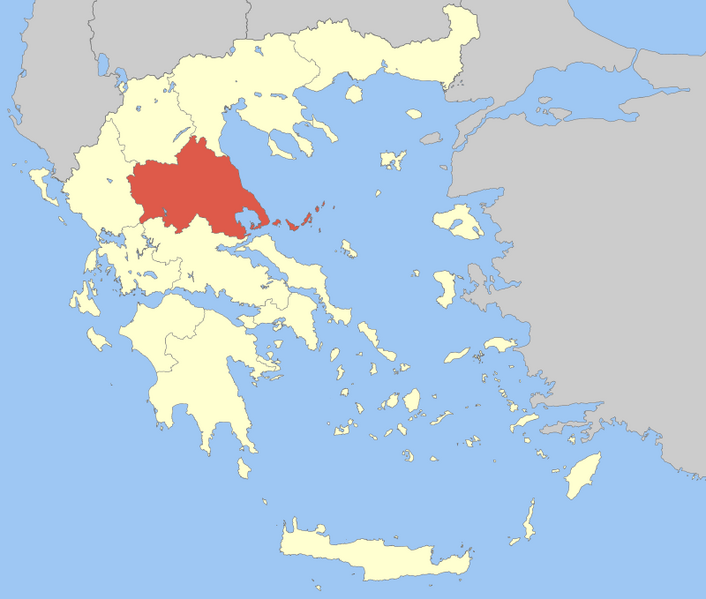
Thessaly became part of the
modern Greek state
in 1881, after four and a
half centuries of
Ottoman
rule. Since 1987 it has formed one of
the country’s 13
regions
and is further (since the
Kallikratis reform
of 2010) sub-divided into 5
regional units
and 25
municipalities
. The capital of the region is
Larissa
. Thessaly lies in central Greece and
borders the regions of
Macedonia
on the north,
Epirus
on the west,
Central Greece
on the south and the
Aegean Sea
on the east. The Thessaly region
also includes the
Sporades
islands.
History
Ancient history
Thessaly was home to an extensive
Neolithic
culture around
2500 BC
.
Mycenaean
settlements have also been
discovered, for example at the sites of
Iolcos
,
Dimini
and
Sesklo
(near
Volos
). In Archaic and
Classical
times, the lowlands of Thessaly
became the home of baronial families, such as the
Aleuadae
of
Larissa
or the Scopads of Crannon. In the 4th
century BC
Jason of Pherae
transformed the region into a
significant military power, recalling the glory of Early Archaic times. Shortly
after
Philip II of Macedon
was appointed Archon
of Thessaly, and Thessaly was thereafter associated with the Macedonian Kingdom
for the next centuries. Thessaly later became part of the
Roman Empire
as part of the province of
Macedonia
. The region of Thessaly in the 7th
century, experienced an influx of
Slavic
warlords,
Perboundos
the Slavic king who established
permanent settlement in
Macedonia
also included Thessaly, as part of
his Slavic realm and region. He named the region “Belzetia” and appointed a lord
to govern and peacefully maintain order. The Slavic
Belegezites
tribes, under king Perboundos began
building settlements and agricultural farms known as
subsistance communal farms
. The lord of
Thessaly
Akamir
was at war with the
Roman Empire
, and by 700 AD a fortress was
fully built. The Slavs of Macedonia had included Thessaly as part of
Sklavinia
, the
Battle of Larissa
occurred in 780 AD.
Medieval and
Ottoman Thessaly
Thessaly remained part of the East Roman “Byzantine” Empire after the
collapse of Roman power in the west, and subsequently suffered many invasions,
such as by the Slavic tribe of the
Belegezites
in the 7th century AD. Following
the campaigns of the Byzantine general
Staurakios
in 782-783, the Byzantine Empire
recovered Thessaly (then known as
Hellas
), taking many Slavs as prisoners.[4]
In 977 it was raided by the Bulgarians. Dissatisfaction about the taxation
policy led in 1066 the Aromanian and Bulgarian population of Thessaly to revolt
against the Byzantine Empire under the leadership of a local lord,
Nikoulitzas Delphinas
.[5]
The revolt, which began in
Larissa
, was soon expanded in
Trikala
and later northwards to the
Byzantine-Bulgarian border. In 1199-1201 another unsuccessful revolt was led by
Manuel Kamytzes
, son-in-law of Byzantine
emperor
Alexios III Angelos
.[6]
In 1204 it was assigned to
Boniface of Montferrat
and in 1225 to
Theodore Komnenos Doukas
, despot of
Epirus
. From 1271 to 1318 it was an independent
despotate that extended to
Acarnania
and
Aetolia
, run by
John I Doukas
. In 1309 settled there the
Almogavars
or
Catalan Company
of the East (Societas
Catalanorum Magna), which in 1310, after lifting the siege of Thessalonica,
withdrew as mercenaries in the pay of the
sebastokrator
John II Doukas
, and took over the country
organized in a democracy. From there they departed to the
Duchy of Athens
, called by the duke
Walter I
. In 1318, with the extinction of the
Angelid
dynasty, the Almogavars occupied
Siderokastron and southern Thessaly (1319) and formed the
duchy of Neopatria
.

One of the flags used in Thessaly during the
Greek War of Independence
(designed
by
Anthimos Gazis
).
In 1348, it was invaded and occupied by the
Serbs
under
Preljub
. After the latter’s death in 1356, the
region was conquered by
Nikephoros Orsini
, and after his death three
years later, it was taken over by the self-proclaimed Serbian emperor
Simeon Uroš
. Simeon’s son
John Uroš
succeeded in 1370 but abdicated in
1373, and Thessaly was administered by the Greek Angeloi-Philanthropenoi clan
until the
Ottoman
conquest c. 1393. Ottoman control was
disputed by the Byzantines until the 1420s, when it was consolidated by
Turahan Bey
, who settled
Turkomans
in the province and founded the town
of Tyrnavos
.
In 1821, parts of Thessaly and
Magnesia
participated in the initial uprisings
in the
Greek War of Independence
, but these revolts
were swiftly crushed. Thessaly became part of the modern Greek state in 1881,
after the
Treaty of Berlin
.
Geography

Volos
view from
Pelion
mountain.
Thessaly occupies the east side of the
Pindus
watershed, extending south of Macedonia
to the Aegean Sea
. The northern tier of Thessaly is
defined by a generally southwest-northeast spur of the Pindus range that
includes
Mount Olympus
, close to the Macedonian border.
Within that broken spur of mountains are several basins and river valleys. The
easternmost extremity of the spur extends southeastward from Mt. Olympus along
the Aegean coast, terminating in the
Magnesia
Peninsula that envelops the
Pagasetic Gulf
(also called the Gulf of Volos),
and forms an inlet of the Aegean Sea. Thessaly’s major river, the
Pineios
, flows eastward from the central Pindus
Range just south of the spur, emptying into the
Thermaic Gulf
.
The Trikala
and
Larissa
lowlands form a central plain which is
surrounded by ring of mountains. It has a distinct summer and winter season,
with summer rains augmenting the fertility of the plains. This has led to
Thessaly occasionally being called the “breadbasket of Greece”.
The region is well delineated by topographical boundaries. The
Chasia
and
Kamvounia
mountains lie to the north, the Mt.
Olympus massif to the northeast. To the west lies the Pindus mountain range, to
the southeast the coastal mountains of
Óssa
and
Pelion
.
Several tributaries of the Pineios flow through the region.
Demographics
According to the census conducted by ESYE in 2011, the population of the
region of Thessaly is 732,762 and represents 6.8% of the total population of the
country.
It has noted a 2.8% decrease in the population since 2001 and remains the
third largest region in the country population-wise.
The population break-down is 44% urban, 40% agrarian and 16% semi-urban with
the agrarian population having noted a decline which has been paralleled with an
increase in the semi-urban.
The metropolitan area of Larissa, the capital of Thessaly, is home to more
than 230,000 people, making it the biggest city of the region.
Major communities
,_Greece_01.jpg/220px-Litheos_river,_Trikala_(city),_Greece_01.jpg)
Litheos river flowing through city of
Trikala
.
Economy
The alluvial soils of the
Pineios
Basin and its tributaries make Thessaly
a vital agricultural area, particularly for the production of
grain
,
cattle
, and
sheep
. Modernization of agricultural practices
in the mid-20th century has controlled the chronic flooding that had restricted
agricultural expansion and diversification in the low-lying plains. Thessaly is
the leading cattle-raising area of
Greece
, and
Vlach
shepherds shift large flocks of
sheep
and
goats
seasonally between higher and lower
elevations. The last decades, there is a rise in cultivating dried nuts such as
almonds
,
pistachios
and
walnuts
especially in the region of
Almyros
. Rise in the number of olive oil trees
have been also observed. The nearly landlocked
Gulf of Pagasai
provides a natural harbor at
Volos
for shipping the agricultural products
from the plains just to the west and chromium from the mountains of Thessaly.
Transport
There are a number of highways
E75
and the main railway from
Athens
to
Thessaloniki
(Salonika) crosses Thessaly. The
region is directly linked to the rest of Europe through
International Airport of Central Greece
located
in Nea Anchialos
in a small distance from
Volos
and
Larisa
. Until today
charter
flights links the region and brings
tourists to the wider area, mainly in
Pelion
and
Meteora
. The new infrastructure includes a
brand new terminal ready to serve 1500 passengers per hour and new airlanes.
Administration
The Thessaly region was established in the 1987 administrative reform. In
everyday use, “Thessaly” is identified with the administrative region, although
the historical region extended south into
Phthiotis
and at times north into
West Macedonia
as well.
With the 2010
Kallikratis plan
, the powers and authority of
the region were redefined and extended. Along with
Central Greece
, it is supervised by the
Decentralized Administration of Thessaly and Central Greece, based at
Larissa
. The region is based at
Larissa
and is divided into five
regional units
(four were pre-Kallikratis
prefectures
),
Karditsa
,
Larissa
,
Magnesia
, the
Sporades
and
Trikala
, which are further subdivided into 25
municipalities
.
The region’s governor is, since 1 January 2011,
Konstantinos Agorastos
, who was elected in the
November 2010 local administration elections
for the
New Democracy
party.
Mythology
In Homer
‘s epic, the
Odyssey
,
Odysseus
visits the kingdom of Aeolus, and this
is the old name for Thessaly.
The Plain of Thessaly, which lies between
Mount Oeta
/Othrys and
Mount Olympus
, is the site of the
battle
between the
Titans
and the
Olympians
.
According to legend,
Jason
and the
Argonauts
launched their search for the Golden
Fleece from the Magnesia Peninsula.
|













,_Greece_01.jpg/220px-Litheos_river,_Trikala_(city),_Greece_01.jpg)
